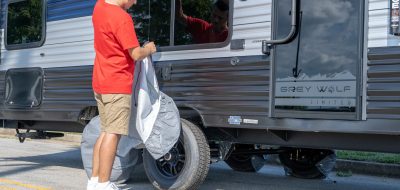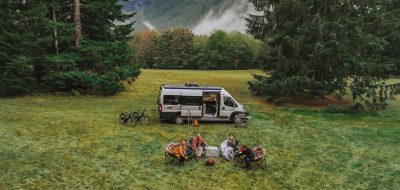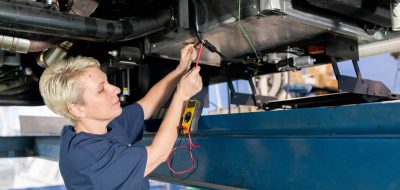When Pierre Charles L’Enfant gazed northward along the banks of the Potomac River in 1791, he envisioned a magnificent city, calling the area a “pedestal waiting for a moment.” He could never have pictured today’s monumental capital city, where public transportation makes it easy for visiting RVers to explore dozens of American landmarks. Quite simply, Washington, D.C. welcomes RVers with an array of colorful neighborhoods (including many tasty restaurants in Georgetown), culture, government buildings, museums, memorial and, of course, lots of monuments.
Strategically located midway along the eastern seaboard and right on the Potomac River, the Washington, D.C. metropolitan area actually refers to the District of Columbia, seven Maryland counties, five Virginia counties, and six Virginia cities (historic and easily accessible Alexandria in Northern Virginia is a particular favorite for visiting RVers).
Public Transportation
The area is notorious for heavy traffic at times, so veteran visitors recommend choosing a convenient campground and then taking advantage of the excellent public transportation system in the area. The Washington Metropolitan Area Transit Authority (WMATA; wmata.com) makes it relatively easy to explore the area, with more than 100 miles of Metrorail track and 86 stations, plus 1,500 buses in the Metro bus system (there’s even RV parking at several stations, making it easy to park and ride for those who didn’t leave their RV at the campground). Once downtown, getting around by foot, WMAT A services, taxi, or tour bus is much easier than with any size RV.
What to See in D.C.
Any list of sightseeing options in and around D.C. will be monumental. The possibilities, which are generally less crowded during non-summer months, can include: the National Mall; the Washington Monument; the National Zoological Park; Smithsonian Institution Museums; the White House (and its relatively new residents); the U.S. Capitol; the Supreme Court; the National Archives; the Jefferson, Lincoln, FOR, Korean, Vietnam and World War II memorials (plus many more); the U.S. Holocaust Memorial Museum; the intriguing International Spy Museum; the John F. Kennedy Center for the Performing Arts (a “living memorial” with three theaters and much more); the National Geographic Explorers Hall (since RVers are explorers by nature); and the neighborhoods of Georgetown and ethnically diverse Adams-Morgan. Many of these options and others are free or low-cost, making a D.C. visit affordable (especially for RVers who bring along their own accommodations).
Other Attractions
Situated along the western banks of the Potomac south of Washington, D.C. proper and known as ”The Fun Side of the Potomac,” historic Alexandria, Virginia is also very visitor-friendly. Accessed by frequent public ferries, the Metro, buses and the convenient City Marina, reaching Alexandria is easy. Once there, highlights of very walk-able Old Town Alexandria might include: the Torpedo Factory (marina, shops, restaurants and more in an old World War I torpedo parts plant); the recently reopened Stabler-Leadbeater Apothecary Museum; Gadsby’s Tavern Museum; Christ Church; The Lyceum (Alexandria’s history museum); cobblestone Prince Street, and dozens of other historic homes and buildings. George Washington’s home Mount Vernon is a short drive or boat ride away (and well worth a visit!).
Even further afield, other easily-reached and -explored destinations that might interest RVers include: historic Annapolis (Maryland’s capital); the Civil War battlefields of the Manassas area in Northern Virginia; Baltimore; the bucolic “Delmarva” peninsula (the Delaware, Maryland, and Virginia coast); and more. For those based at a D.C.-area campground, public transportation can connect with Amtrak to reach many of these other areas. Thus, from Washington, D.C. proper to more options in Alexandria and beyond, this is surely one of America’s capital RV destinations. Whether you want fall colors or lots of red, white, and blue, our nation’s capital and the rest of the capital region await. For information to plan your trip, contact Destination D.C. visit washington.org.
Nearby Campgrounds
Several D.C.-area campgrounds are strategically located near public transportation. A few favorites include; Duncan’s Family Campground (duncansfamilycampground.com) and Greenbelt Park (http://www.nps.gov/gree). Though there are other possibilities in the area, one of ore of these three varied options will be an ideal base for Washington, D.C. area exploration.
Located about 20 miles southeast of the capital in Maryland, full-service Duncan’s Family Campground has been a family-run operation for more than 35 years. They offer van transportation to the nearby Metro and guided tours leave right from the campground (plus, there’s even a new Dog Park of which they’re particularly proud).
Just 10 miles or so north of downtown D.C. in suburban Maryland (just outside the Capital Beltway), Cherry Hill Park (“A Monumental Experience”) is another full-service option, with city buses that stop right a the campground at least hourly and run straight to the nearby Metro stop. Gray Line guided tours also pick up three times a day inside the campground for full- and half-day sightseeing trips. For information on Cherry Hill Park visit, cherryhillpark.com/index.cfm
Also located in suburban Maryland about a dozen miles north of the capital proper, Greenbelt Park is a National Park Service option. There are no electric or water hookups here, both the park’s hiking, naturel programs, and convenience (note that RVers will need to get themselves to the nearby Metro stop) all make for a unique D.C. area base. The rustic campsites aren’t huge, so larger RVs may need to pay for two sites.
Link to above: http://www.npca.org/parks/greenbelt-park.html?adwords=1&gclid=CIfSsPvc97MCFU-d4Aod7nYABw






